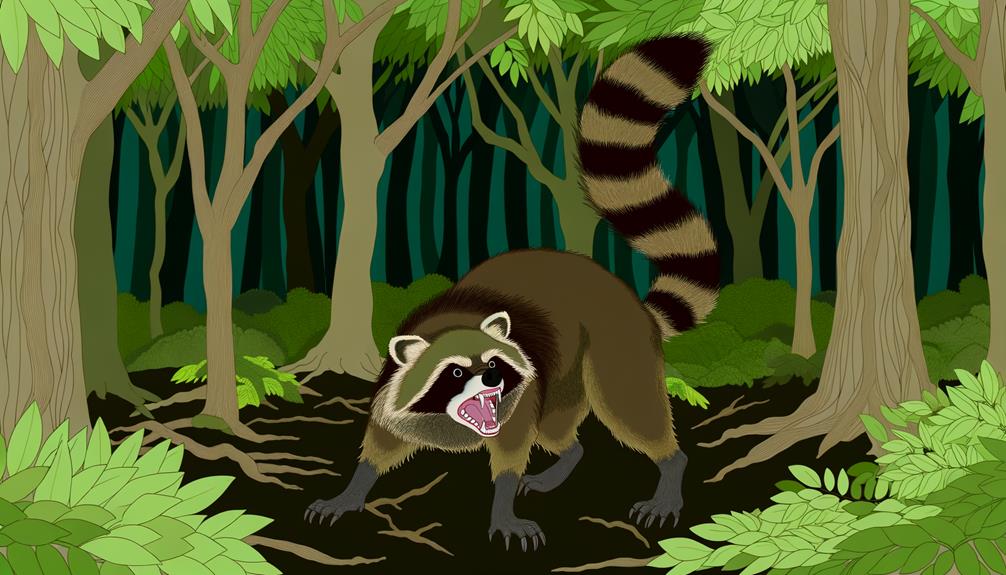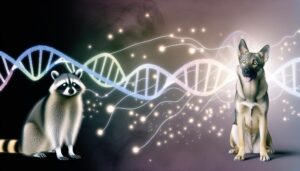How Do Raccoon Dogs Protect Themselves?
Raccoon dogs, known as Tanuki, employ tactical protection methods to survive. They react to threats by feigning death, a process involving thanatosis—a decrease in metabolic activity to mimic death.
In addition, they use piloerection to puff up their fur, appearing larger to dissuade potential predators. Varied vocalizations, such as growls, barks, and whines, also play a pivotal role in communication and defense.
Raccoon dogs further demonstrate adaptability through behavioral changes with the seasons and strategic habitat selection. Continue ahead to gain in-depth insights into these fascinating survival strategies.

Key Takeaways
- Raccoon dogs use thanatosis, or playing dead, to deter predators by understanding their necrophobia.
- They exhibit piloerection, puffing up their fur to appear larger and intimidate potential threats.
- Various vocalizations, like growls and barks, are used to communicate danger and ward off predators.
- Raccoon dogs undergo physical adaptations like thickening of fur and metabolic changes for survival.
- Their habitat selection in areas with diverse food sources and secure dens aids in self-protection and survival.
Understanding Raccoon Dog Behavior
Observing with keen scientific interest, one can discern that the behavior of raccoon dogs, or Nyctereutes procyonoides, showcases a unique blend of adaptability and self-preservation strategies, deeply embedded in their instinctual responses. These animals exhibit a fascinating ability to survive in a broad range of environments, from forests to urban areas, through their impressive flexibility in diet and habitat selection.
This adaptability is coupled with an innate sense of self-preservation, as evidenced by their mainly nocturnal habits and cautious approach towards potential threats. Evidently, they have developed a highly effective mechanism of feigning death when confronted by predators, a strategy that will be discussed in further detail in the next subtopic. Such behaviors underscore the raccoon dog's remarkable resilience and survival instincts.
The Art of Playing Dead
The raccoon dog utilizes a unique self-protection mechanism, commonly known as 'playing dead.' This behavior involves understanding necrophobia, or the fear of the dead, which many predators exhibit, causing them to avoid lifeless prey.
In this section, we will analyze the specifics of this survival strategy, focusing on the technique itself and the role of deception in its successful execution.
Understanding Necrophobia
In an intriguing display of self-defense, raccoon dogs exhibit a behavior known as necrophobia, an act of playing dead that serves as a survival mechanism in threatening situations. This fascinating response is not only an illustration of the animal's instinctual drive for survival but also a proof to its adaptability in the face of danger. Necrophobia, while seemingly passive, is a strategic decision that empowers the raccoon dog with the ability to control its fate when faced with a threat.
| Behavior | Purpose |
|---|---|
| Necrophobia | Evasion of Predators |
| Stillness | Minimize Attention |
| Mimicked Death | Deterrence of Predators |
In essence, necrophobia is a manifestation of the raccoon dog's desire for freedom – its instinctive struggle against the imposition of external threats and its inherent drive to live autonomously.
Playing Dead Technique
Expanding on the concept of necrophobia, it's important to dissect the specifics of the raccoon dog's technique of playing dead, a skillful act that requires careful execution and strategic timing.
When threatened, the raccoon dog induces a state of apparent lifelessness, a phenomenon known as thanatosis. This state is characterized by a notable decrease in metabolic activity and the suspension of voluntary muscle control. The raccoon dog's heart rate and breathing markedly slow, simulating death convincingly to potential predators.
While this technique might seem straightforward, it is an intricate process involving complex physiological changes. Importantly, the raccoon dog must discern when to employ this strategy, as misuse could result in actual harm. This technique embodies the raccoon dog's innate desire for freedom and survival.
Survival Through Deception
Employing a masterful blend of physiology and psychology, raccoon dogs manipulate their apparent mortality as a survival tool, employing the art of playing dead to deceive potential predators. This strategic deception involves a complex series of physiological responses, including a reduction in heart rate and breathing to mimic death convincingly.
The physical act is complemented by an impressive psychological component, as the raccoon dog remains completely immobile and unresponsive, even in the face of direct interaction. This duality of feigned death, both physiological and psychological, is an unparalleled survival mechanism, allowing these creatures to avoid conflict and potential harm.
It is an eloquent manifestation of evolution's ingenuity in crafting survival strategies, underlining the intricate interplay between biology and behavior in the animal kingdom.
Puffing Up Fur: Intimidation Tactic
The phenomenon of puffing up fur, known scientifically as piloerection, serves as an intimidating tactic utilized by raccoon dogs in self-defense situations. This physiological response triggers the contraction of tiny muscles at the base of each hair follicle, causing the fur to stand on end. The apparent increase in size serves to dissuade potential predators, offering a non-violent yet effective means of protection.
This tactic, similar to strategies observed in other species, is an embodiment of the 'fight or flight' response. It leverages the element of visual perception, using the simple illusion of increased size to generate fear in adversaries.
It is a clear demonstration of how raccoon dogs, like all creatures, exploit natural mechanisms to guarantee their survival in a world where freedom is often contingent on the ability to deter threats.
Raccoon Dogs' Vocal Threats
In addition to the visual intimidation by puffing up their fur, raccoon dogs also resort to vocal threats as part of their self-protection repertoire. They use a variety of vocalizations, including growls, barks, and whines to communicate danger and ward off potential threats.
These sounds vary in pitch and intensity, often increasing in response to the growing proximity or threat level of a predator. Acoustic analysis reveals a complexity in their vocalizations, indicating a sophisticated form of communication.
This vocal strategy not only acts as a deterrent for predators but also serves to alert fellow raccoon dogs of imminent danger, embodying their instinctual drive for self-preservation and freedom. Therefore, vocal threats form a pivotal part of the raccoon dogs' defensive arsenal.
Seasonal Adaptations for Survival
Mastering the art of seasonal adaptation, raccoon dogs employ a variety of survival tactics in response to the changing environment throughout the year. They undergo a remarkable transformation in their physical appearance from a thin summer coat to a thick winter fur. This morphological change is pivotal in maintaining body temperature and conserving energy during the cold months.
Concurrently, their metabolic rate slows down, a phenomenon known as torpor, which allows them to survive with less food. In contrast, during the warmer months, they exhibit high levels of activity and foraging to accumulate fat reserves and prepare for the ensuing winter. Therefore, their survival strategy is a nuanced interplay of physiological and behavioral changes, essential for their success in the wild.
Raccoon Dogs and Human Interaction
Often coming into contact with humans due to their expanding habitat range, raccoon dogs demonstrate a remarkably adaptable behavior that varies from avoidance to opportunistic exploitation of human resources. These interactions, depending on the circumstances, can either be beneficial or harmful to the survival of the species.
Insights about these interactions can be gained from the table below:
| Interaction | Impact |
|---|---|
| Crop Raiding | Detrimental due to possible human retaliation |
| Urban Areas Scavenging | Beneficial as it provides easy food sources |
| Pet Trade | Detrimental due to stress and unsuitable living conditions |
This table shows that while raccoon dogs are adaptable, their interactions with humans can often pose significant threats. Understanding and managing these interactions are essential for the survival and freedom of the species.
Importance of Habitat Selection
Selecting the appropriate habitat plays a vital role in the survival and propagation of raccoon dogs, influencing their access to food, shelter, and protection from predators. The raccoon dog's habitat choice is a strategic, adaptive response to environmental pressures.
These canids prefer riparian zones, forested areas, and abandoned human settlements, which offer diverse food sources and fewer predator threats. The availability of denning sites also factors into habitat preference, as secure dens are critical for successful reproduction and offspring protection.
Through careful habitat selection, raccoon dogs mitigate risks and maximize resource availability. This ecological plasticity allows raccoon dogs to flourish across a wide range of habitats, demonstrating their resilience in the face of fluctuating environmental conditions.
Conclusion
Finally, the Raccoon Dog displays a captivating mix of behavioral and physiological adaptations for survival, from pretending to be deceased to fluffing up their fur for intimidation.
Their vocal warnings act as a caution to potential predators, while their seasonal adjustments guarantee year-round survival.
Noteworthy is their specific habitat choice, which acts as a symbolic stronghold against threats.
A thorough grasp of these defense mechanisms contributes to the conservation and protection of this distinctive species.






